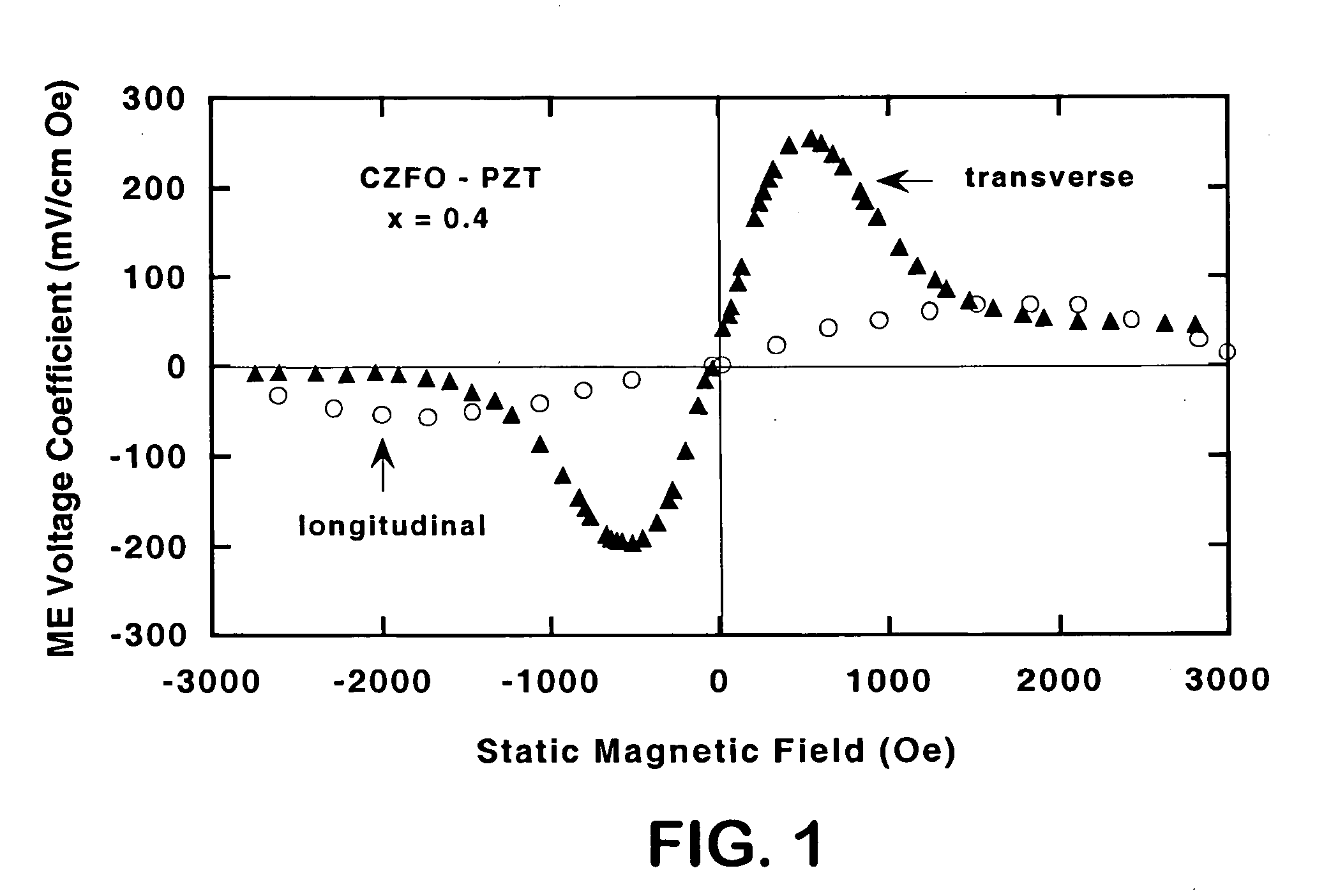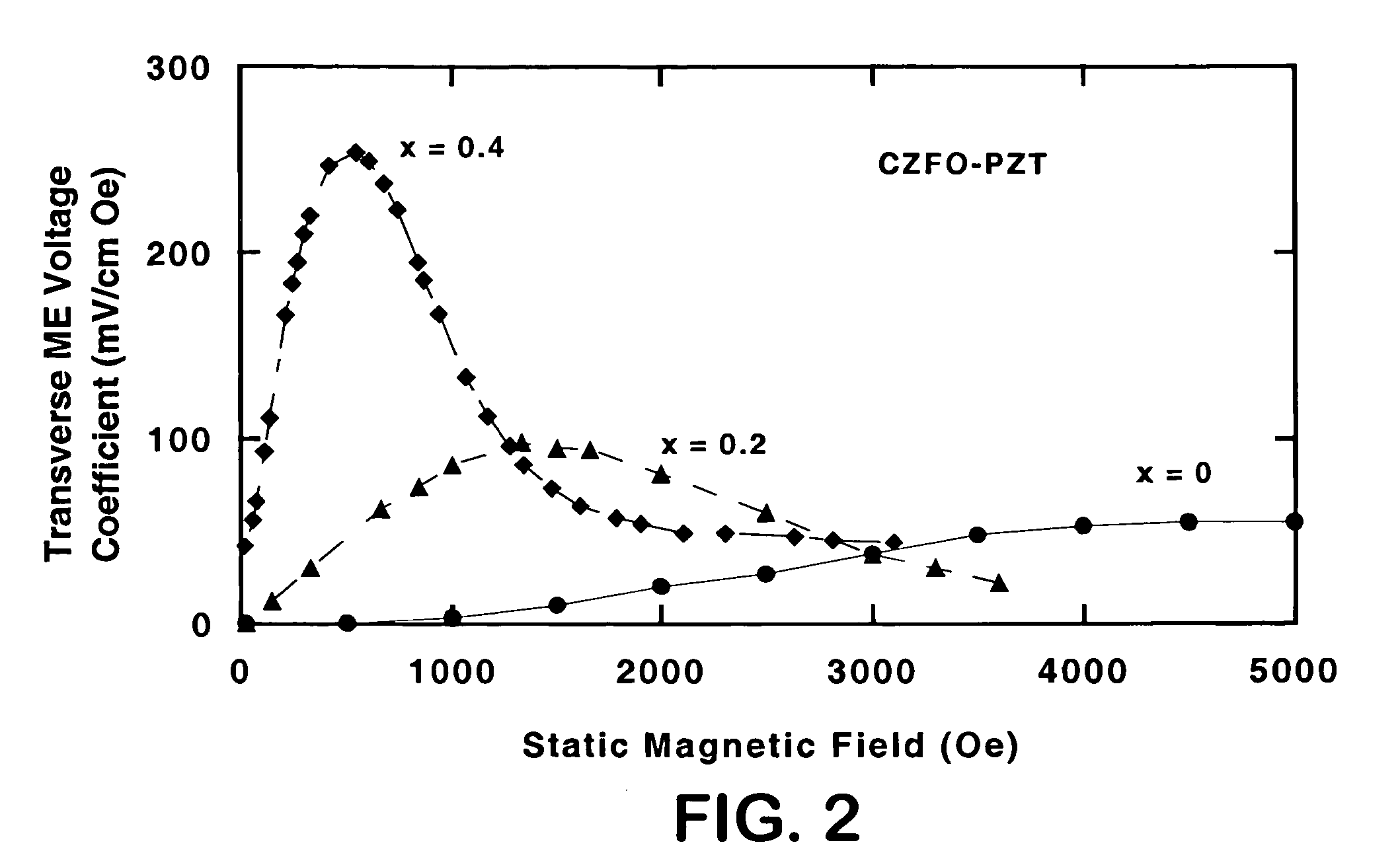Magnetoelectric multilayer composites for field conversion
a multi-layer composite and field conversion technology, applied in the field of magnetic multi-layer composites, can solve the problems of reduced me coefficients, poor mechanical coupling, lack of interest in such transducers, etc., and achieve the effect of large me coefficients, large me effect, and maximum field conversion efficiency
- Summary
- Abstract
- Description
- Claims
- Application Information
AI Technical Summary
Benefits of technology
Problems solved by technology
Method used
Image
Examples
example 1
[0093] This example provides an understanding of the effects of the magnetic parameters of ferrites on ME coupling in multilayers with PZT. It is possible to accomplish controlled variations in such parameter with Zinc substitution in ferrites. The following oxides were used for the magnetic phase: cobalt zinc ferrite, Co1-xZnxFe2O4 (CZFO) (x=0-0.6), nickel zinc ferrite Ni1-xZnxFe2O4 (NZFO) (x=0-0.5), and lithium zinc ferrite Li0.5-x / 2ZnxFe2.5-x / 2O4 (LZFO) (x=0-0.4). Commercially available PZT was used for the piezoelectric phase.
I. Materials and Methods
[0094] Layered composites were synthesized using thick films of ferrites and PZT obtained by tape casting (Mistler and Twiname, Tape Casting: Theory and Practice, The American Ceramics Society, Westerville, Ohio (2000)). The ferrite powder necessary for tape casting was prepared by the standard ceramic techniques that involved mixing the oxides or carbonates of the constituent metals, followed by pre-sintering, and final sintering...
example 2
[0121] This example illustrates the formation of nickel zinc ferrite-lead zirconate titanate (NZFO-PZT) bilayers and multilayers. Both NZFO-PZT bilayers and multilayers were synthesized from thick films prepared by tape casting. The process involved (i) preparation of submicron-sized powder of nickel zinc ferrite (NZFO) and lead zirconate titanate (PZT), (ii) thick-film tapes by doctor-blade techniques, and (iii) lamination and sintering of bilayers and multilayers.
[0122] NZFO powder was obtained by standard ceramic techniques and commercial PZT (Sample No. APC850) was obtained from American Piezo Ceramics, Inc., Mackeyville, Pa.) were used. For tape casting (Mistler et al., In Tape Casting: Theory and Practice (American Ceramics Society, Westerville, Ohio, 2000), powders of NZFO and PZT were each mixed with a solvent such as ethyl alcohol and a dispersant such as Blown Menhaden fish oil (available from Richard E. Mistler, Inc., Morrisville, Pa.) and ball milled for 24 hours, follo...
example 3
[0124] This example illustrates the formation of cobalt zinc ferrite-lead zirconate titanate (CZFO-PZT) bilayers and multilayers. Both CZFO-PZT bilayers and multilayers were synthesized from thick films prepared by tape casting. The process involved (i) preparation of submicron-sized powder of cobalt zinc ferrite (CZFO) and lead zirconate titanate (PZT), (ii) thick-film tapes by doctor-blade techniques, and (iii) lamination and sintering of bilayers and multilayers.
[0125] CZFO powder was obtained by standard ceramic techniques and commercial PZT (Sample No. APC850) was obtained from American Piezo Ceramics, Inc., Mackeyville, Pa.) were used. For tape casting, powders of CZFO and PZT were each mixed with a solvent such as ethyl alcohol and a dispersant such as Blown Menhaden fish oil and ball milled for 24 hours, followed by a second ball mill with a plasticizer such as butyl benzyl phthalate and a binder such as polyvinyl butyral for 24 hours to produce a slurry of CZFO and a slurr...
PUM
| Property | Measurement | Unit |
|---|---|---|
| thickness | aaaaa | aaaaa |
| thickness | aaaaa | aaaaa |
| frequency | aaaaa | aaaaa |
Abstract
Description
Claims
Application Information
 Login to View More
Login to View More - R&D
- Intellectual Property
- Life Sciences
- Materials
- Tech Scout
- Unparalleled Data Quality
- Higher Quality Content
- 60% Fewer Hallucinations
Browse by: Latest US Patents, China's latest patents, Technical Efficacy Thesaurus, Application Domain, Technology Topic, Popular Technical Reports.
© 2025 PatSnap. All rights reserved.Legal|Privacy policy|Modern Slavery Act Transparency Statement|Sitemap|About US| Contact US: help@patsnap.com



